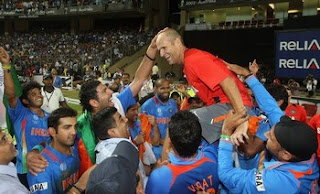The Cricket World Cup 2011 has just ended after 6 weeks (yes 6 weeks) of cricket on the sub-continent with the trophy finally ending up in the hands of the Indian cricket team. At least one South African can say they've held the World Cup Trophy aloft. ;-)
Research has shown that the physiological demands of cricket are relatively mild, with the most demands on fast bowlers. The demands of cricket are intermittent in nature with ‘spells’ of high intensity activity interspersed with prolonged periods of active rest.
Time-motion analysis of batsmen, fast bowlers, fielders, spin bowlers and wicketkeepers were quantified during four Twenty20 (T20) cricket matches. A total of 18 different players were monitored over 30 innings. The study showed that cricketers covered up to 8.5 km, with just less than 1 km of this distance spent sprinting during an 80 min fielding innings.
Fast Bowlers covered 8.5 km; sprinted ± 42 times, mean sprint distance was ±17m and total sprinting distance was ± 1 km.
Wicketkeepers covered ± 6.5 km; sprinted ± 5 times, mean sprint distance was ± 10m and total sprinting distance was ± 100m.
Batsmen covered ± 2.5 km; sprinted ± 15 times, mean sprint distance was ± 14m and total sprinting distance was ± 250m during a 30 minute innings.
The result of the research shows that fast bowlers and fielders have substantially greater physical demands than spin bowlers and wicketkeepers in T20 cricket. The same could be said of the sport in the longer format of One Day International (ODI) cricket.
For batsmen, bowlers, and fielders, the primary energy system utilized during competition is the anaerobic processes (ATP-PCr and Glycolytic systems). In the acts of bowling, batting, and fielding, the intervals of activity requiring energy generation to power the athletes' muscles will almost certainly be fewer than 40 seconds. As all players in cricket are at some stage of a match called on to bat and field, much basic fitness training will be common to all players. Cricket training is not exclusively an anaerobic focus. Players are often either positioned in the field or batting for an extended period of time. Enhanced aerobic fitness and a strong cardiovascular system assist the players in dealing with the fatigue and impact on their attentiveness in the course of a long match.
Source
Petersen, C.; Portus, D.B.; Dawson, M.R. 2009“Quantifying positional movement patterns in Twenty20 cricket” International Journal of Performance Analysis in Sport 9 (2)165-170


No comments:
Post a Comment